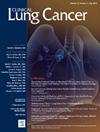80岁及以上非小细胞肺癌患者的肿瘤免疫表型相关性和一线派姆单抗在PD-L1高(≥50%)患者中的预后
IF 3.3
3区 医学
Q2 ONCOLOGY
引用次数: 0
摘要
背景:年龄≥80岁的非小细胞肺癌(NSCLC)患者在临床试验中的代表性不足。我们评估了在PD-L1肿瘤比例评分(TPS)≥50%、年龄≥80岁的晚期NSCLC患者中,年龄是否与不同的免疫表型相关,或是否影响一线派姆单抗的疗效。方法:回顾性分析三个NSCLC队列,以评估年龄的影响(结果:在队列A (N = 669)中,≥80岁的患者(N = 111)与年轻患者(N = 558)相比,在客观缓解率或中位无进展生存期方面没有显着差异,但中位总生存期较短,并且在派姆单抗进展后接受二线治疗的可能性较小。在队列B (N = 567)中,来自≥80岁的患者(N = 45)的肿瘤表现出更高的肿瘤内FOXP3+ T细胞和更接近PD-1+免疫细胞的肿瘤细胞。结论:≥80岁的pd - l1高NSCLC患者在TME中表现出独特的免疫表型,但与年轻患者相比,一线派姆单抗获得了相似的ORR和mPFS。老年患者的OS较短,他们不太可能接受二线治疗。本文章由计算机程序翻译,如有差异,请以英文原文为准。
Tumor Immunophenotypic Correlates in Patients Aged 80 Years or Older With Non-Small Cell Lung Cancer and Outcomes to First-Line Pembrolizumab in PD-L1 High (≥50%) Patients
Background
Non-small cell lung cancer (NSCLC) patients aged ≥80 years [y] are underrepresented in clinical trials. We evaluated whether age correlates with a distinct immunophenotype or impacts outcomes to first-line pembrolizumab in patients with advanced NSCLC, PD-L1 Tumor Proportion Score (TPS) of ≥50%, and aged ≥80y.
Methods
Three NSCLC cohorts were retrospectively analyzed to assess the impact of age (<80y versus ≥80y) on pembrolizumab efficacy and the tumor microenvironment (TME). Cohort A encompassed patients receiving first-line pembrolizumab for advanced NSCLC with PD-L1 ≥50%. Cohort B comprised patients with tumor profiling using multiplexed immunofluorescence (ImmunoPROFILE). Cohort C included The Cancer Genome Atlas (TCGA) and Stand Up to Cancer (SU2C) databases for gene expression analysis.
Results
In Cohort A (N = 669), patients ≥80y (N = 111) showed no significant differences in objective response rate or median progression-free survival compared to younger patients (N = 558), but had shorter median overall survival and were less likely to receive second-line therapy after progression on pembrolizumab. In Cohort B (N = 567), tumors from patients ≥80y (N = 45) exhibited higher intratumoral FOXP3+ T cells and closer vicinity of PD-1+ immune cells to tumor cells compared to <80y (N = 522). Cohort C revealed a distinct immunophenotype in samples from patients ≥ 80y, with elevated specific immune cell subsets and up-regulated immune checkpoint proteins.
Conclusion
Patients ≥80y with PD-L1-high NSCLC displayed a distinct immunophenotype in the TME but achieved similar ORR and mPFS with first-line pembrolizumab compared to younger patients. OS was shorter in older patients, who were less likely to receive second-line therapy.
求助全文
通过发布文献求助,成功后即可免费获取论文全文。
去求助
来源期刊

Clinical lung cancer
医学-肿瘤学
CiteScore
7.00
自引率
2.80%
发文量
159
审稿时长
24 days
期刊介绍:
Clinical Lung Cancer is a peer-reviewed bimonthly journal that publishes original articles describing various aspects of clinical and translational research of lung cancer. Clinical Lung Cancer is devoted to articles on detection, diagnosis, prevention, and treatment of lung cancer. The main emphasis is on recent scientific developments in all areas related to lung cancer. Specific areas of interest include clinical research and mechanistic approaches; drug sensitivity and resistance; gene and antisense therapy; pathology, markers, and prognostic indicators; chemoprevention strategies; multimodality therapy; and integration of various approaches.
 求助内容:
求助内容: 应助结果提醒方式:
应助结果提醒方式:


